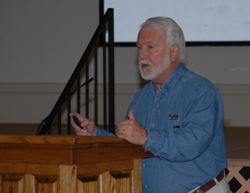|
Control Costs, AgCenter Experts Tell Farmers
DELHI, LA.
Louisiana farmers should follow cost-effective production strategies for the 2015 growing season, LSU AgCenter experts said at the annual northeast Louisiana crops forum on Feb. 2.
“We’re in a new environment,” said AgCenter economist Kurt Guidry. The past few years were profitable with good prices; now, prices are falling.
Consider market conditions when you make decisions, and know your breakeven levels, Guidry said. “It’s time for risk management, not profit maximization.”
Growers need to consider their resources, their risk preferences and their comfort level, he said. “This year, bottom-line targets are reaching break even. We need to make sure we have enough income to cover costs.”
Guidry said he expects more “traditional” price movements in 2015.
Not using harsh chemicals when you don’t have to saves money, said AgCenter entomologist Sebe Brown. “When commodity prices are low, you can sacrifice some yield to insects” because the cost of treatment may be more than the value of the yield saved.
Follow thresholds and avoid prophylactic applications if possible, Brown said. Prophylactic applications of chemicals can kill beneficial insects and drive resistance to chemical controls.
Brown recommended treating cotton seed for thrips, but the AgCenter is no longer recommending Cruiser-treated seed. “If you have it, overtreat with Gaucho,” he said. Experts are seeing Cruiser resistance in tobacco thrips.
Tests show a 20 percent yield with seed treatment followed by a later foliar treatment.
Poncho is the best treatment in corn, Brown said. A seed treatment vs. no treatment demonstrated an average 14-bushel yield increase over a 13-year time span.
In soybeans, it doesn’t matter what product you use as long as you use seed treatments, Brown said. “Seed treatments in beans pay off more times than not.”

LSU AgCenter fertility specialist J Stevens tells farmers to price their fertilizer per pound of nutrient during the northeast Louisiana crop forum on Feb. 3 in Delhi.
Photo by Rick Bogren
“Soybean pathogens have developed resistance to strobilurin and benzimidazole fungicides,” said AgCenter plant pathologist Trey Price. Three of four commonly used chemistries on the market have a high risk for resistance development.
Frogeye leaf spot was the most prevalent soybean disease in the state last year. “The best option is to plant a frogeye-resistant variety. This can save the cost of multiple fungicide applications in a bad frogeye year,” Price said.
Growers have many fungicide options. “If an application is necessary, don’t put out a bad application of a good fungicide with inadequate rate, nozzles or spray volume resulting in poor coverage,” Price said. “You’re throwing your money away.”
When growers rotate crops, they should rotate herbicides as well, said AgCenter weed scientist Daniel Stephenson.
Choice of preplant herbicides depends on the weeds in the field, Stephenson said. “It’s a shoppers’ market for herbicide choices, of which there are many.”
“Invest now or pay later,” he said. “If you back off weed control, when you get bit, you’re going to get bit hard.”
Weed control includes more than herbicides. “Weed-free seed is important,” Stephenson said. “Keep your equipment clean so you don’t spread weeds from one field to another. And row spacing can help shade soil to prevent weed germination.”
Eliminating weeds keeps insect and disease pressures down, Stephenson said.
Adequate soil fertility and proper application of fertilizers can go a long way toward managing production costs, said AgCenter fertility specialist J Stevens.
“If we don’t supply plants with what they need, then those plants will never reach their genetic potential,” Stevens said. "The best way to supply nutrients is by starting with a soil test.”
Follow recommendations as close as you can, Stevens said. “You want your nutrients to be available when you need them. Follow a plan”
Farmers should take time to learn about the nutrients that are identified in a soil test, Stevens said.
“Plants can ‘talk,’” he said. “You have to ‘listen’ with your eyes. If you don’t know what you’re seeing, find someone who does.”
“Think about what your plants need,” he said. “Don’t cut your plants short.” ∆
|
|